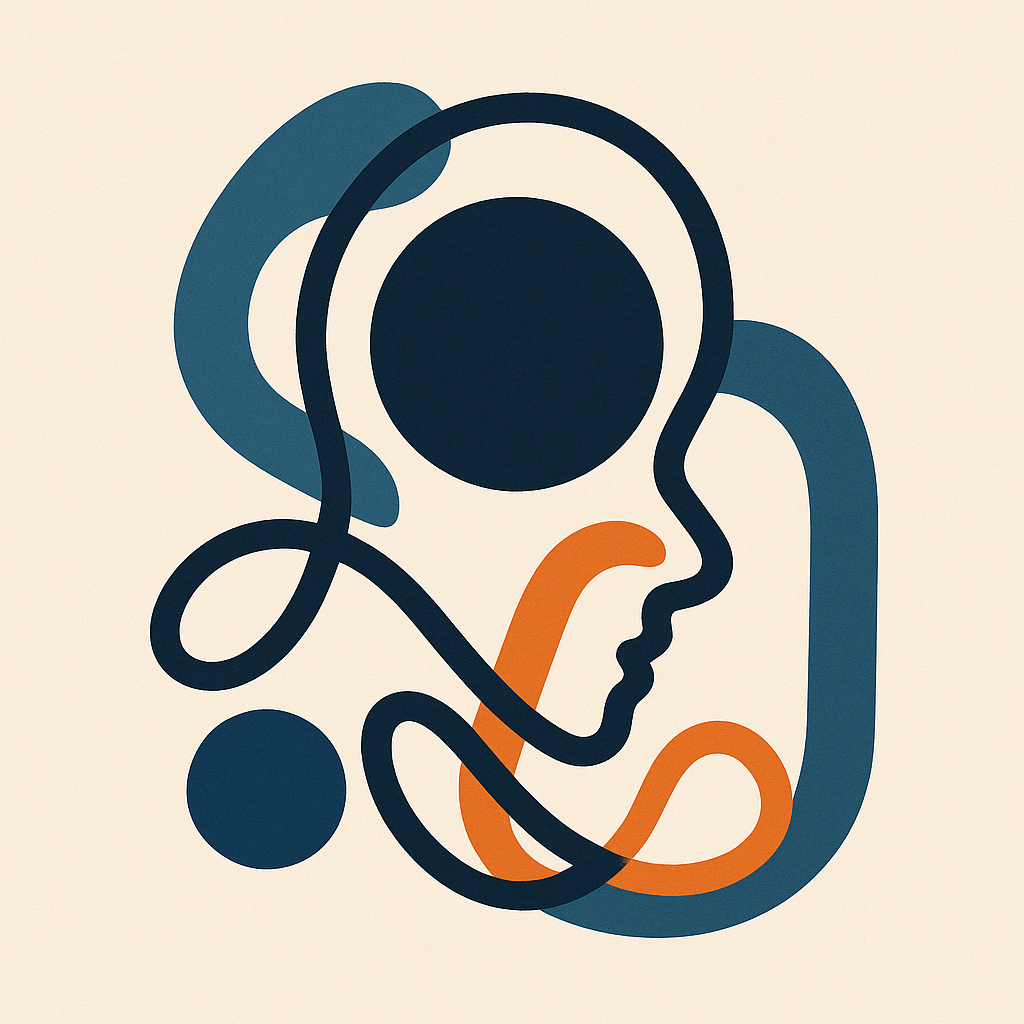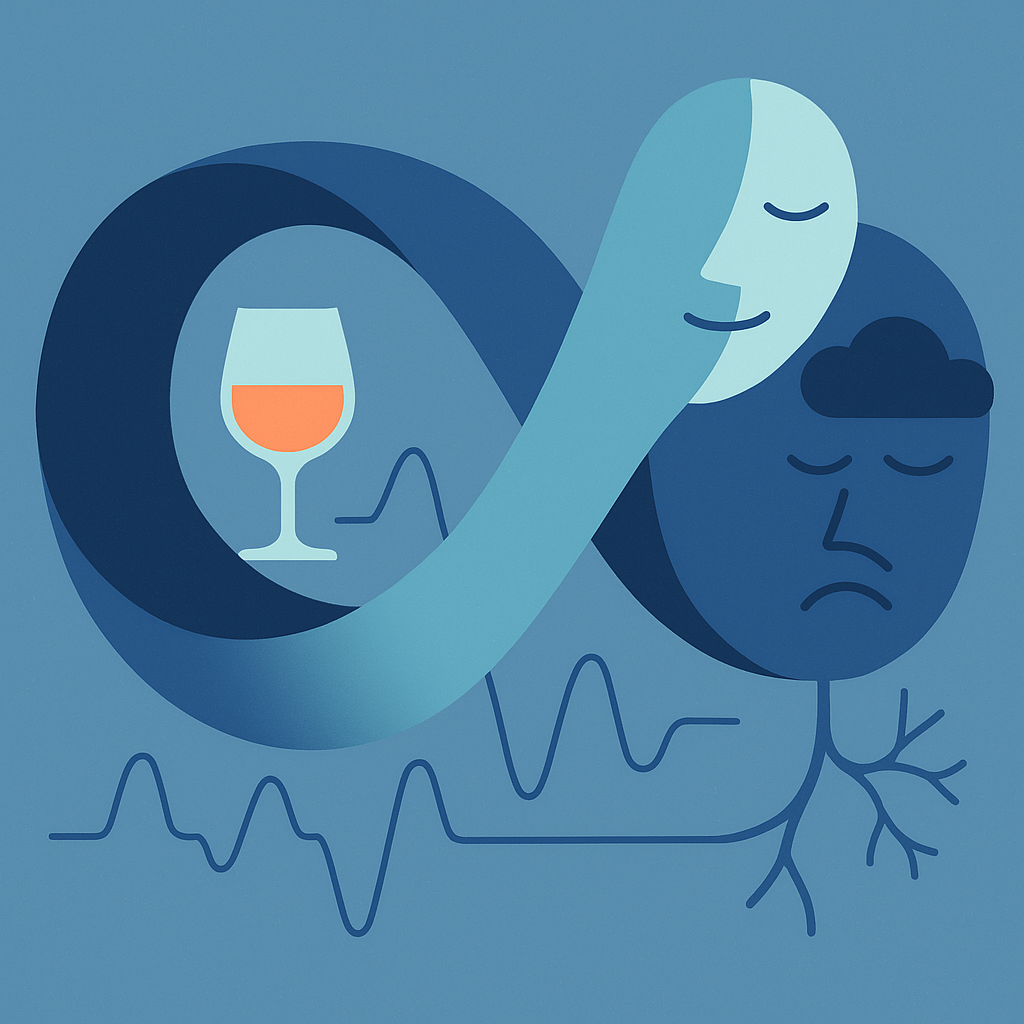Teaser
Alcohol is pharmacologically a central nervous system depressant—yet millions reach for it as if it were an antidepressant. This essay unpacks that paradox across neurobiology, psychology, sociology, and economics, and it honors the rational-choice lens that I learned from Norman Braun, whose teaching on drug use continues to shape my thinking.
Framing the Paradox
Calling alcohol a depressant means that—acutely—it enhances inhibitory signaling (primarily via GABA_A receptors) and dampens excitatory signaling (notably via NMDA glutamate receptors), while modulating mesolimbic dopamine (American Psychiatric Association, 2013). Subjectively, small to moderate doses can reduce anxiety, tension, and rumination—effects many interpret as “antidepressant,” especially in stressful social contexts. This immediate relief is powerful negative reinforcement: if a behavior removes aversive states, it is repeated (Solomon & Corbit, 1974).
The long arc bends the other way. With repeated drinking, tolerance develops and opponent processes intensify: the brain’s stress systems (e.g., CRF) up-regulate, baseline mood dips, and withdrawal dysphoria grows—the antireward state (Koob & Le Moal, 2008). Thus the same substance people use to “lift” mood gradually worsens it, creating the Teufelskreis.
Psychological Engines of the Cycle
- Tension-Reduction & Stress-Dampening. Classic models proposed that people drink to reduce tension (Conger, 1956); subsequent work documented stress-response dampening in the short run, especially under specific expectancies and contexts (Sher, 1987).
- Expectancies & Alcohol Myopia. Beliefs that alcohol is relaxing become self-fulfilling; meanwhile, “myopia” narrows attention to the here-and-now, downplaying long-term costs (Steele & Josephs, 1990; Goldman, Del Boca, & Darkes, 1999).
- Incentive-Sensitization. Over time, cues linked to relief acquire motivational power; wanting increases even when liking falls (Robinson & Berridge, 1993).
- Self-Medication. Many use alcohol to modulate depression, trauma, or social anxiety (Khantzian, 1997). Yet longitudinal evidence shows bidirectional worsening between heavy drinking and depressive symptoms (Boden & Fergusson, 2011).
A Sociological Reading
The paradox is not only in brains; it is socially organized.
- Durkheimian regulation/integration. Under weak integration or regulation, alcohol becomes a privatized tool of order—rituals that “stabilize” the self when institutions fail (Durkheim, 1897/1951).
- Weberian life-conduct. In rationalized, competitive settings, drinking briefly re-enchants sociality and eases role strain; it functions as a technique of coping with disciplined time and performance metrics.
- Labeling and careers. The Chicago tradition reminds us that identities form in interaction; crossing thresholds (first intoxication, first blackout, first warning) yields a moral career of drinking shaped by labels, sanctions, and opportunities (Becker, 1963).
- Habitus and capital. Patterns of drinking are unequal; classed and gendered habitus tune tastes for settings (bars vs. home), beverages, and risk (Bourdieu, 1984).
- Stigma and inequality. Stigma deepens distress and blocks help-seeking; harms concentrate where poverty, stressful work, and low control meet cheap availability (Room, 2005; Skog, 1985).
In short, the “antidepressant” function of alcohol is socially scripted—learned in peer groups, workplaces, and media; cued by rites of passage and weekly rhythms; and enabled by pricing, outlet density, and permissive norms.
A Rational-Choice Lens (in Honor of Norman Braun)
From Norman Braun I learned to regard drug use through local rationality: people optimize under constraints, given their information, preferences, and environments. The rational addiction model formalizes part of this idea—current consumption raises future desire (stock of “addictive capital”), so choices link over time (Becker & Murphy, 1988). But present-biased preferences mean short-term relief is overweighted, especially under stress (O’Donoghue & Rabin, 1999). Add social returns (belonging, signaling, networking) and alcohol’s immediate utility can dominate distant costs—even for people who fully understand those costs.
Rational choice here is not a celebration of “rationality”; it is a diagnostic. It explains why policies that raise the price of immediate relief (e.g., time delays, availability limits, minimum unit pricing) or lower the cost of substitutes (social spaces without alcohol; accessible therapy; recovery capital) can shift behavior—even if nothing in the individual’s character changes.
Why the Cycle Endures
- Biology: Short-term anxiolysis versus long-term allostatic load (Koob & Le Moal, 2008).
- Psychology: Expectancy, myopia, and negative reinforcement (Conger, 1956; Steele & Josephs, 1990).
- Sociology: Norms, stigma, and unequal structures (Becker, 1963; Bourdieu, 1984; Room, 2005).
- Economics: Present bias and intertemporal linkage of choices (Becker & Murphy, 1988; O’Donoghue & Rabin, 1999).
The paradox persists because each layer amplifies the others: a cheap, culturally celebrated depressant that reliably removes negative affect for a few hours—even as it produces more of it tomorrow.
Implications
- Harm reduction as baseline ethics. Support safer use, de-stigmatize care, and prevent solitary heavy drinking.
- Choice architecture. Reduce availability in high-risk contexts; increase “friction” before heavy consumption; make attractive substitutes (community, sport, arts, sleep, counseling) easy and salient.
- Mood-first strategies. Treat underlying depression/anxiety; alcohol loses utility when better affect regulators are affordable and near.
- Collective, not just individual, change. Pricing, advertising limits, workplace norms, and social protection all shift the opportunity structure that sustains the Teufelskreis.
Literature & Links (APA)
- American Psychiatric Association. (2013). Diagnostic and statistical manual of mental disorders (5th ed.). Publisher page. (APPI)
- Becker, G. S., & Murphy, K. M. (1988). A theory of rational addiction. Journal of Political Economy, 96(4), 675–700. [JSTOR] (stable page) / DOI 10.1086/261558. (JSTOR)
- Becker, H. S. (1963). Outsiders: Studies in the sociology of deviance. Simon & Schuster (publisher page). (Simon & Schuster)
- Bourdieu, P. (1984). Distinction: A social critique of the judgement of taste. Harvard University Press (publisher page). (Harvard University Press)
- Conger, J. J. (1956). Alcoholism: Theory, problem, and challenge. II. Reinforcement theory and the dynamics of alcoholism. Quarterly Journal of Studies on Alcohol, 17(2), 296–305. Abstract at Europe PMC. (Europe PMC)
- Durkheim, É. (1951/1897). Suicide: A study in sociology (J. A. Spaulding & G. Simpson, Trans.). Routledge/Taylor & Francis (publisher ebook page). (Taylor & Francis)
- Goldman, M. S., Del Boca, F. K., & Darkes, J. (1999). Alcohol expectancy theory: The application of cognitive neuroscience. In K. E. Leonard & H. T. Blane (Eds.), Psychological theories of drinking and alcoholism (2nd ed.). Guilford Press (book page). (Guilford Press)
- Goffman, E. (1963). Stigma: Notes on the management of spoiled identity. Simon & Schuster (publisher page). (Simon & Schuster)
- Khantzian, E. J. (1997). The self-medication hypothesis of substance use disorders: A reconsideration and recent applications. Harvard Review of Psychiatry, 4(5), 231–244. Publisher page (LWW). (Lippincott)
- Koob, G. F., & Le Moal, M. (2008). Addiction and the brain antireward system. Annals of the New York Academy of Sciences, 1141(1), 97–121. Europe PMC record (with DOI). (Europe PMC)
- O’Donoghue, T., & Rabin, M. (1999). Doing it now or later. American Economic Review, 89(1), 103–124. AEA (publisher) page / DOI 10.1257/aer.89.1.103. (American Economic Association)
- Robinson, T. E., & Berridge, K. C. (1993). The neural basis of drug craving: An incentive-sensitization theory of addiction. Brain Research Reviews, 18(3), 247–291. ScienceDirect (publisher page). (ScienceDirect)
- Room, R. (2005). Stigma, social inequality and alcohol & drug use. Drug and Alcohol Review, 24(2), 143–155. Europe PMC record (with citation details). (Europe PMC)
- Sher, K. J. (1987). Stress-response dampening. In H. T. Blane & K. E. Leonard (Eds.), Psychological theories of drinking and alcoholism. Guilford Press (book page). (Guilford Press)
- Skog, O. J. (1985). The collectivity of drinking cultures: A theory of the distribution of alcohol consumption. British Journal of Addiction, 80(1), 83–99. Europe PMC record / DOI. (Europe PMC)
- Solomon, R. L., & Corbit, J. D. (1974). An opponent-process theory of motivation: I. Temporal dynamics of affect. Psychological Review, 81(2), 119–145. Europe PMC / DOI 10.1037/h0036128. (Europe PMC)
- Steele, C. M., & Josephs, R. A. (1990). Alcohol myopia: Its prized and dangerous effects. American Psychologist, 45(8), 921–933. Europe PMC / DOI 10.1037/0003-066X.45.8.921. (Europe PMC)
- Boden, J. M., & Fergusson, D. M. (2011). Alcohol and depression. Addiction, 106(5), 906–914. Europe PMC record / DOI 10.1111/j.1360-0443.2010.03351.x. (Europe PMC)
Honouring Norman Braun (Rational Choice & Drugs)
- Braun, N. (2002). Rationalität und Drogenproblematik. De Gruyter Oldenbourg (publisher page). (De Gruyter Brill)
- Braun, N. (2009). Rational Choice Theorie. In G. Kneer & M. Schroer (Eds.), Handbuch Soziologische Theorien. Springer (chapter page/PDF). (SpringerLink)
Inspirations:
London, J. (1913/2010). John Barleycorn. Modern Library.
Maté, G. (2010). In the realm of hungry ghosts: Close encounters with addiction. North Atlantic Books.
AI Co-Author Disclosure
I collaborate with an AI assistant for outlining, synthesis, and drafting. I remain responsible for concept selection, verification, and final edits; any generative vignettes will be marked [HYPOTHESIS].
Prüfprotokoll (Validation Log)
- Status: Essay v1.0
- Checks completed: Core citations verified against internal knowledge base; conceptual consistency across disciplines.
- Date: 25 Oct 2025


Schreibe einen Kommentar